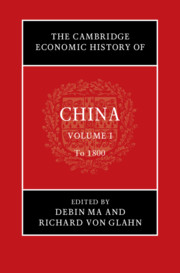Book contents
- The Cambridge Economic History of China
- The Cambridge Economic History of China
- The Cambridge Economic History of China
- Copyright page
- Contents
- Figures
- Maps
- Tables
- Contributors to Volume I
- Acknowledgments
- Note on Citations
- Introduction to Volume I
- Part I Before 1000
- 1 The Economy of Late Pre-imperial China
- 2 Agriculture and Its Environmental Impact
- 3 State and Economy
- 4 Money, Markets, and Merchants
- 5 Economic Philosophy and Political Economy
- 6 Silk Road Trade and Foreign Economic Influences
- Interlude
- Part II 1000 to 1800
- Bibliography of Primary Works Cited
- Index
- References
6 - Silk Road Trade and Foreign Economic Influences
from Part I - Before 1000
Published online by Cambridge University Press: 07 February 2022
- The Cambridge Economic History of China
- The Cambridge Economic History of China
- The Cambridge Economic History of China
- Copyright page
- Contents
- Figures
- Maps
- Tables
- Contributors to Volume I
- Acknowledgments
- Note on Citations
- Introduction to Volume I
- Part I Before 1000
- 1 The Economy of Late Pre-imperial China
- 2 Agriculture and Its Environmental Impact
- 3 State and Economy
- 4 Money, Markets, and Merchants
- 5 Economic Philosophy and Political Economy
- 6 Silk Road Trade and Foreign Economic Influences
- Interlude
- Part II 1000 to 1800
- Bibliography of Primary Works Cited
- Index
- References
Summary
The Silk Road trade, which involved mostly prestige goods, started from the Han dynasty, around the second century bce, under the protection of Han imperial expansion into Central Asia. The economy of the Han Empire was mainly based on agriculture. Taxes in the form of agricultural products – such as food grains, silk yarn and floss, and bast-weave cloths such as ramie and hemp – in addition to corvée labor provided the major revenue for the state. Although commerce flourished in cities and connected both rural and urban residents into a nationwide market, traders held the lowest status in the social hierarchy. The impetus for trade with foreign countries, therefore, was initiated by the Han ruling elite, who, like aristocrats in ancient regimes around the world, had always been looking for rare and expensive goods to mark their distinguished status. Meanwhile, the Han Empire engaged in warfare with pastoral nomads of the Central Asian steppe grasslands from the founding of the dynasty. The perennial wars with the Xiongnu nomad confederation extended the horizon of the Han rulers, north to the steppe and west to Central and South Asia, reaching as far as the Mediterranean.
- Type
- Chapter
- Information
- The Cambridge Economic History of China , pp. 203 - 240Publisher: Cambridge University PressPrint publication year: 2022



